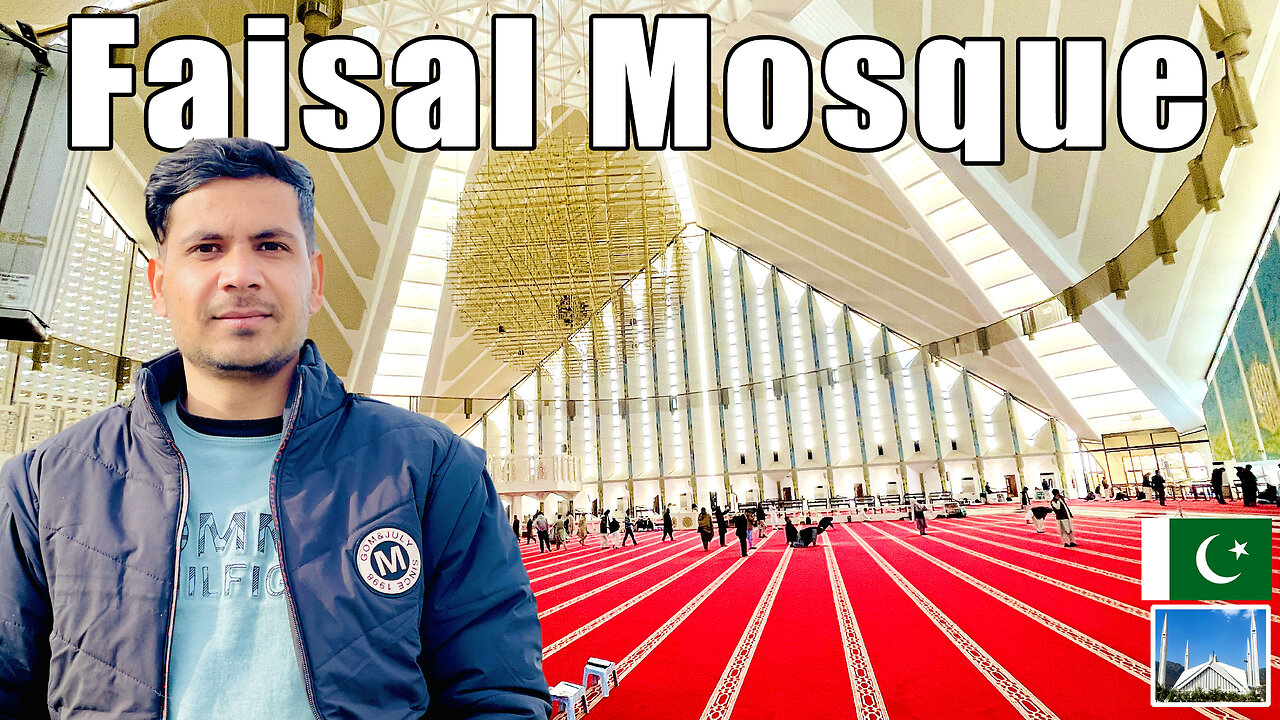Premium Only Content

I Went to Faisal Mosque Before RAMADAN Month to Explore Inside of the Mosque🇵🇰
#FaisalMosque #FaisalMosqueIslamabad #Pakistan #Islamabad #Ramadan #FaisalMosqueinRamadan #RamadanFaisalMosque #FaisalMosquetouristattraction #FaisalMosquelocation #FaisalMosqueenvironment
SUBSCRIBE:
https://www.youtube.com/channel/UCMtEIkXQR-NKSQufy7BrW7w?sub_confirmation=1
Follow us:
------------------------------------------------
1.YouTube Short Channel:
https://www.youtube.com/@SattarKhanzadaShorts
2.Instagram:
https://www.instagram.com/sattar_khanzada?igsh=ZzdwY3Jma2FqOThh&utm_source=qr
3.Tiktok:
https://www.tiktok.com/@sattarkhanzada0?_t=8jLdRGrE37Z&_r=1
4.Facebook:
https://www.facebook.com/profile.php?id=100089791817042&mibextid=kFxxJD
0:00 Introduction
0:36 Restaurant Environment
0:52 Breakfast Menu
2:24 Breakfast Meal
4:43 Saidpur Village Environment
6:10 Handcraft Dress
Faisal Mosque is an iconic mosque in Islamabad, Pakistan, renowned for its contemporary design and grand scale. It stands as a symbol of the deep-rooted Islamic culture in Pakistan and reflects the modernist approach the country adopted in many aspects of its development. Here's an overview of its significance, design, and history:
Historical Background
Inception and Construction: The idea for the mosque was conceived in 1966, and it was designed by the Turkish architect Vedat Dalokay. The mosque's construction was financed by the Saudi King Faisal bin Abdul-Aziz, after whom it is named. Its construction began in 1976 and was completed in 1986.
King Faisal's Role: King Faisal of Saudi Arabia was instrumental in the mosque's development, both financially and ideologically. The mosque was named after him following his assassination in 1975 as a tribute to his contribution.
Architectural Design
Unique Structure: Unlike traditional mosque designs that feature domes and minarets, Faisal Mosque has a contemporary design resembling a Bedouin tent. This innovative design marked a departure from conventional mosque architecture and was initially met with some skepticism.
Capacity and Scale: It is one of the largest mosques in the world, with the main prayer hall capable of accommodating over 10,000 worshippers. Including the surrounding porticoes and courtyard, the mosque can hold upwards of 100,000 people.
Location and Orientation: Set against the picturesque backdrop of the Margalla Hills, its location and orientation do not follow the traditional alignment towards Mecca. Instead, the mosque's main prayer hall faces the Kaaba in Mecca diagonally, a unique aspect of its design.
Cultural and Religious Significance
Symbol of Islamic Pride: The mosque is a symbol of Islamic pride and unity in Pakistan. It represents a blend of Islamic culture with modern architecture, showcasing the country's progressiveness and its deep roots in Islamic traditions.
Educational and Religious Center: Besides being a place of worship, the mosque also houses the International Islamic University, making it a center for Islamic learning and scholarship. This adds to its significance as a place for both religious observance and education.
Tourism and Recognition
Landmark Status: Faisal Mosque is not only a place of worship but also one of Islamabad's primary landmarks and a major tourist attraction. Its unique architecture and the beauty of its surrounding landscape draw visitors from all over the world.
#FaisalMosque #FaisalMosqueIslamabad #Pakistan #Islamabad #Ramadan #FaisalMosqueinRamadan #RamadanFaisalMosque #FaisalMosquetouristattraction #FaisalMosquelocation #FaisalMosqueenvironment
-
 LIVE
LIVE
Illyes Jr Gaming
1 hour agoBack to Black .....Ops 6 w/ ILLYESJRGAMING
55 watching -
 1:07:59
1:07:59
BonginoReport
4 hours agoBoston Mayor Defies Trump, Protects Illegals - Nightly Scroll w/ Hayley Caronia (Ep.115)
79.8K53 -
 40:45
40:45
Donald Trump Jr.
5 hours agoPeace by Peace: Solving One Problem After Another | Triggered Ep.268
39.9K50 -
 LIVE
LIVE
FrizzleMcDizzle
2 hours agoRemnant 2 - Dark Souls-like Shooter?!
101 watching -
 LIVE
LIVE
FoeDubb
1 hour ago🏰KINGDOM MENU: 🏈FOOSBALL & 🎮DELTA FORCE PEW PEWS DILLY DILLY!!
24 watching -
 11:43:31
11:43:31
GritsGG
12 hours agoWin Streaking! Most Wins 3390+ 🧠
53.3K -
 1:08:29
1:08:29
TheCrucible
5 hours agoThe Extravaganza! Ep. 24 (8/19/25)
72.9K15 -
 4:22:25
4:22:25
sophiesnazz
6 hours ago $0.55 earnedLETS TALK ABOUT BO7 !socials !specs
13.2K -
 1:27:30
1:27:30
Redacted News
5 hours ago"There will be consequences!!!" Trump issues big threat to Putin ahead of peace summit | Redacted
97.8K159 -
 LIVE
LIVE
Amish Zaku
3 hours agoWar Thunder - Tank Tuesday - then Peak
60 watching